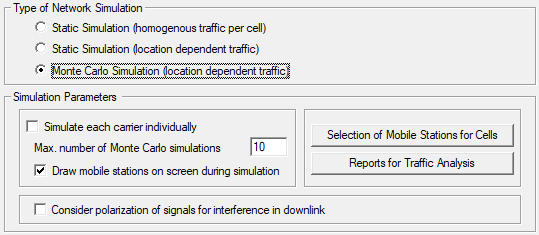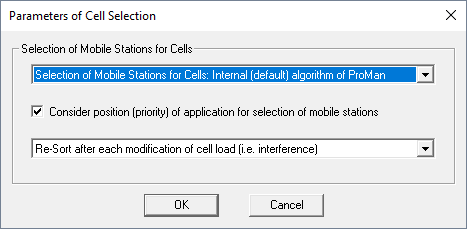Simulation Parameters
Click or click the ![]() .
.

Figure 1. The Simulation parameters dialog.
Type of Network Simulation
For radio network planning different types of simulations are available. Static simulations can be done either with homogeneous traffic assumptions for each cell of the networks, for example, using cell loads, or with location dependant traffic definitions. Monte Carlo Simulations use randomly distributed users, which are generated according to location dependant traffic definitions.
Simulation Parameters

Figure 2. The Parameters of Cell Selection dialog.
- Simulate Each Carrier Individually
- For network projects with multiple assigned (frequency) carriers the ProMan provides the additional option to simulate each carrier individually. In this case the results are generated for each carrier individually (based on the individual cell assignment, assuming only the investigated carrier is defined) plus the “superposed” results considering all defined carriers (based on the corresponding cell assignment considering all carriers). Accordingly the “superposed” results include the resulting value for the serving cell on each pixel (the throughputs from different carriers are not superposed).
- Maximum number of Monte Carlo simulations
- Maximum number of snapshots (random samplings) during Monte Carlo
simulation.Note: This option is only available if Monte Carlo Simulation (location dependent traffic) check box is selected.
- Draw mobile stations on screen during simulation
- Draw mobile stations generated for each snapshot.Note: This option is only available if Monte Carlo Simulation (location dependent traffic) check box is selected.
- Selection of Mobile Stations for Cells
- This option allows you to change the algorithm for the selection of mobile stations during cell assignment. Besides a default algorithm which is implemented in WinProp, it is also possible to implement a user-defined algorithm for the assignment of mobile stations to the cells of the network via an open application interface.
- Cell load and traffic definitions used for interference calculations
- These settings are specified on the Traffic Settings tab.
- Interference Ratios
- [Optional] Consider the influence of the polarization on the transmitted
signals.

Figure 3. The Interference ratios dialog.If transmitting antennas with different polarizations (V/H or +45°/-45°) are used within the radio network the co-channel interference depends on the polarization. Individual interference ratios depending on the LOS/NLOS situation and the polarization relation can be defined. Orthogonal polarization means 90° difference (for example, V and H for the two considered antennas) and different polarization means 45° difference (for example,V and +45° for the two considered antennas).